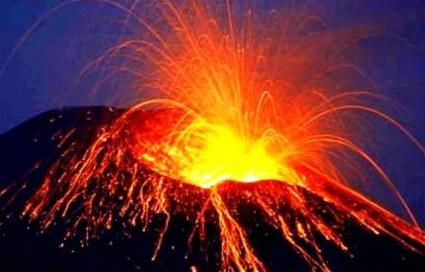What is a Volcano? |
|
A volcano is a mountain that opens downward to a pool of molten rock below the surface of the earth.
|
 |
|
When pressure builds up, eruptions occur.
|
|
Gases and rock shoot up through the opening and spill over or fill the air with lava fragments.
|
 |
|
|
How Volcanoes form and erupt? |
|
Volcanoes are formed when magma from within the Earth's upper mantle works its way to the surface.
|
 |
|
|
|
At the surface, it erupts to form lava flows and ash deposits.
|
|
Over time as the volcano continues to erupt, it will get bigger and bigger.
|
 |
Watch this Video |
Classification of Volcanoes |
|
Scientists have categorized volcanoes into three main categories:
|
|
• Active
|
|
• Dormant
|
|
• Extinct
|
|
An active volcano is one which has recently erupted and there is a possibility that it may erupt soon.
|
|
A dormant volcano is one which has not erupted in a long time but there is a possibility it can erupt in the future.
|
|
An extinct volcano is one which has erupted thousands of years ago and there’s no possibility of eruption.
|
 |
Types of volcanic eruptions |
|
Since volcanoes erupt different from each other, depending on the kind of rising magma as well as other factors, we can distinguish various eruption types/styles.
|
|
The most known types of eruptions are represented by the eruptions observed on:
|
|
• Volcanoes of Hawaii (Hawaiian)
|
|
• Stromboli (Strombolian) volcano
|
|
• Vulcano (Vulcanian)
|
|
• Mount/Montagne Pelée (Pelean)
|
|
• Vesuvius (Plinian)
|
|
However, most of the volcanic eruptions take place unseen on the ocean floor.
|
|
Therefore, they are called submarine eruptions.
|
|
Other types of eruptions include hydrovolcanic eruptions.
|
Types of Volcanoes |
|
• Ash-cinder volcano
|
|
• Composite volcano
|
|
• Shield volcano
|
|
• Dome volcano
|
 |
|
Cinder cones are circular or oval cones made up of small fragments of lava from a single vent that have been blown into the air, cooled and fallen around the vent.
|
 |
|
Composite volcanoes are steep-sided volcanoes composed of many layers of volcanic rocks, usually made from high-viscosity lava, ash and rock debris.
|
|
Mt. Rainier and Mount St. Helens are examples of this type of volcano.
|
 |
|
Shield volcanoes are volcanoes shaped like a bowl or shield in the middle with long gentle slopes made by basaltic lava flows.
|
|
Basalt lava flows from these volcanoes are called flood basalts.
|
|
The volcanoes that formed the basalt of the Columbia Plateau were shield volcanoes.
|
 |
|
Lava domes are formed when erupting lava is too thick to flow and makes a steep-sided mound as the lava piles up near the volcanic vent.
|
|
The eruption of Mount St. Helens in 1980 was caused in part by a lava dome shifting to allow explosive gas and steam to escape from inside the mountain.
|